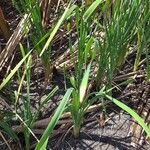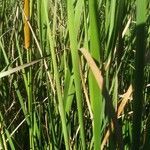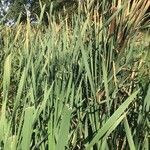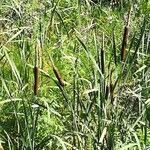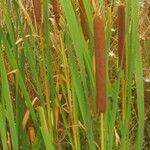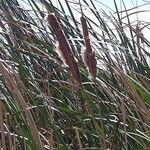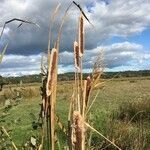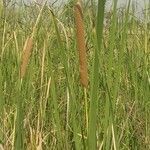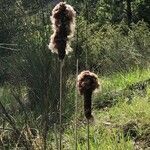Stems 1.6–5 m. high.. Leaf-sheaths with sloping scarious-margined shoulders, rarely rounded, median leaves purple-spotted within and up the base of the blade; blade linear, up to 1.5 m. long, 8–13 mm. wide, with an obtuse tip and narrow base, flat above and convex beneath in dried material, glaucescent or green above, green beneath.. Inflorescence interrupted by a 1–3 cm. long internode, the ♀ spike sometimes interrupted or constricted.. Male spike 17–34(–40) cm. long, 0.9–1.5 cm. wide; bracteoles flattened, forked or laciniate above, rarely linear, red-brown, ± as long as the stamens; stamens with white filaments; anthers 2.5–3.5 mm. long, with the connective produced into a dark globose tip usually broader than the anther, paler when immature; mature pollen grains free, deep primrose-yellow.. Female spike 18–25(–34) cm. long, l.4–2(–2.2) cm. wide, bright chestnut-or reddish-brown at maturity; “pedicels” numerous, subpyramidal with distinct steps 0.5–13 per sq. mm.; bracteoles numerous; stigma linear, scarcely broader than the style butdarker, much longer than the rest of the flower; carpodia numerous, irregularly distributed throughout the spike, appearing as light patches where massed together.. Fig. 1/1–8.
Much like no. 2 [Typha angustifolia L.], but taller (often 2.5–4 m) and with more numerous lvs, these thicker, up to 15 mm wide, often some or all of them exauriculate; pistillate portion of the spike light brown, 1.3–2.5 cm thick at maturity, separated from the staminate portion by up to 8 cm, rarely contiguous with it; pistillate bracteoles acuminate; sterile pistillate fls narrowly cuneate at the tip; hairs subtending the fr white with usually a single large brown cell near the tip; pollen in monads; 2n=30. Pantrop., extending n. in coastal marshes to Md. and Del., and n. inland to Nebr. and Utah.
Stems 0.7-2.5 m tall, stout. Leaves 40-150 cm × 3-8 mm, abaxially convex, transverse section semicircular. Male part of spikes 7-30 cm, with 1 or 2 bracts; bracts to ca. 32 cm, deciduous; female part of spikes 5-23 cm, distinctly separated from male part, with 1 bract at base, with sparse and curved hairs on axis. Male flowers: stamens 3, rarely 2; anthers ca. 1.4 mm. Female flowers with bracteoles; ovary lanceolate; stalk 3-6 mm, slender; styles 0.5-1.5 mm; stigmas linear to lanceolate, 0.8-1.5 mm, broader than styles; hairs on stalk shorter than style. Fruit fusiform. Fl. and fr. Jun-Aug.
Flowering stems usually to 3 m tall. Leaves green or yellowish green; sheath of upper leaves not auriculate or only the uppermost 1 or 2 sheaths distinctly auriculate; lamina to 2 m long, 5–15 mm wide. Male and female inflorescences usually separated by 2–5.5 cm. Male inflorescences usually 15–33 cm long, 0.6–1 cm diam.; pollen shed as single grains. Female inflorescences usually 12–40 cm long, 0.5–2 cm diam., cinnamon-brown; floral bracts abundant, broadly spathulate, usually 4–8 cells across. Stigma linear and often folded longitudinally. [See also Green (1994).]
A tall reed-like plant. It grows in water and keeps growing from year to year. They grow up to 4.5 m high. They form dense thickets around swamps. The leaves are long and blade-like and enclosed in a sheath. They are grass-green. They grow in two opposite rows. The flowers are brown. They are produced in long cylindrical spikes. These look like sausages on spikes. These are up to 20 mm wide. The flowers are usually separated into male (above) and female (below) sections. When mature they turn into a mass of fluff.
